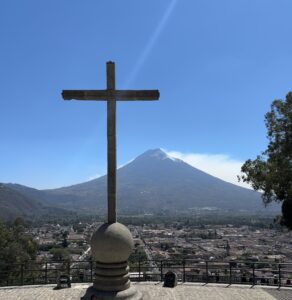by Mary | May 31, 2009 | Uncategorized
I was wondering what I might post today, on the Feast of Pentecost. It seemed like it should be something special, something worthy of the gift of the Holy Spirit. I always used to struggle with that gift, didn’t really get it. I remember when I was young and writing religious music, I composed a song for Pentecost Sunday, but it was a stretch for me, something I had to do to match up to the other feast days I’d celebrated in song. Now that I am older, the Spirit just seems to make more spiritual sense to me. I am more aware of the movement of the Spirit in my own life and in the lives of others. I am comforted by the fact that I am never alone, that God is always with me, surrounding me, blowing through me, hovering over me, whispering into my soul.
Last night, when I was at Mass listening to Father L. preach on Pentecost, he quoted a poem by Mexican poet and mystic Amado Nervo. When I heard it, I knew that this poem needed to be my Pentecost post, so here is the best translation I could find:
Alone we are only a spark,
But in the spirit we are a fire.
Alone we are only a string,
But in the spirit we are a lyre.
Alone we are only an anthill,
But in the spirit we are a mountain.
Alone we are only a drop,
But in the spirit we are a fountain.
Alone we are only a feather,
But in the spirit we are a wing.
Alone we are only a beggar,
But in the spirit we are a king.
by Mary | May 29, 2009 | Uncategorized

This essay ran in the May 24 issue of Our Sunday Visitor:
Out in my perennial garden, nestled among the bleeding hearts and hyacinths, stands a well-worn clay statue of St. Francis of Assisi made by an artisan in Mexico. The unusual characteristics of the statue make it a conversation piece as well as a spiritual touchstone that helps keep me centered as I dig and weed and plant each spring.
Of course, I’m not alone. Drive down any street and you’re likely to find St. Francis peeking out from both well-manicured lawns and wildflower gardens run amuck. He is just as likely to share a garden with a statue of Buddha as he is to share one with a statue of the Blessed Mother. He is a saint of the people – all people, Catholics and non-Catholics alike. His broad appeal is fascinating, but at the same time it begs the question: Do those who plant St. Francis in their gardens really know what the medieval saint was all about?
Today Francis’ concerns are often compartmentalized, separated from Franciscan spirituality by well-meaning folks who want to claim him for their own. And who can blame them? He is certainly a challenging but endearing saint for the ages.
Environmentalists jump on Francis’ love for creation, his “Canticle of Brother Sun,” his diligence in protecting trees and even “brother” fire, and find in him a kindred spirit. Animal lovers hear stories of him preaching to birds and taming a wolf and see in Francis the kind of saint who has rightly earned his status as patron of animals. His popularity comes into full view every Oct. 4, when adults and children alike line up outside churches with everything from goldfish swimming in glass bowls to German shepherds straining at leather leashes just for a chance to get their pets a blessing on Francis’ feast day.
Peace activists, interreligious leaders, social justice organizers — the St. Francis fan club goes on and on. It seems everyone can find a piece of Francis to suit their cause. But, if you put all of those individual causes into the Gospel context that was at the heart of Francis’ rule and spirituality, you come away with a very different picture of our lovable saint, one that is not so easily shaped and molded by the latest trends in activism.
Would we see quite so many St. Francis lawn statues, if we stopped to reflect on the fact that Francis’ life was one centered on his love of Christ, his commitment to a radical living out of the Gospel, and his “marriage” to the bride he dubbed “Lady Poverty”? Do we really look to Francis as a role model, or is he just a pretty face out among the hostas?
The path that St. Francis chose was not an easy one. He was ridiculed and mocked as a madman during his own lifetime for what appeared to be an extreme response to his conversion experience. He renounced his family’s fortune, fasted for days on end, heard the Lord speak to him from a cross in San Damiano, bore the stigmata. He lived and died for Christ. It would be a disservice to him and all he stood for to try to slip a politically correct mask over the spiritually devout saint who did not do anything halfway.
Sometimes I wonder how I can possibly weave Francis’ difficult and often uncomfortable lessons into my exceedingly comfortable existence. How do those of us with warm homes and busy jobs and nice clothes make St. Francis into something more than a decoration or a mascot? It’s not easy, but maybe, just maybe, seeing St. Francis from the kitchen window as we wash dishes or raking leaves from around his feet as we clean the yard will call us back to our spiritual center and remind us that what we do here on this earth cannot be separated from what we long for in heaven.
by Mary | May 27, 2009 | Uncategorized
I received the following anonymous comment this week from someone who attended one of the workshops I gave at the “Living the Catholic Faith Conference” in Denver in February. I wanted to share it because it affirms what I’ve been saying when I take my little show on the road and talk about reaching out to “lost” adult Catholics. We have to reach parents through their children or we may never reach them at all. Here’s what anonymous had to say about her experience:
“I just finished my first year of teaching 1st grade RE. I really like the idea of catechizing the parents through the children. I started making handouts for the kids each week for them to take home with the hope that it would 1) allow parents to reinforce what we taught and 2) teach the parents also. I did have a few of the parents tell me they were learning things they didn’t know through it so felt it had some success. I also made a few pleas in the weekly note about setting a good example in the faith by taking their kids to Mass regularly, and seeing them receiving the sacraments, etc., as the kids would blurt out the fact that they weren’t going to Mass.
“My strategy this year is to do the same in a little newsletter each week that also advertises opportunities for parents as well. Since I’m moving up to 2nd grade, which involves 1st communion/confession prep, I’m hoping to purchase materials like the little St. Joseph 1st Communion Catechism that the kids can keep and take home each week with a little assignment that can get the parents involved as well.”
Thank you, anonymous, for the feedback. It helps tremendously to know that what I’m suggesting actually makes a difference when it’s put into practice. I’ll get to see how my ideas work on a practical level next fall when I start teaching fourth-grade faith formation.
To read more about my take on the “lost generation,” read my earlier post by clicking HERE.
by Mary | May 26, 2009 | Uncategorized
I was surprised last week to find this lovely review of my first book, “Parenting a Grieving Child: Helping Children Find Faith, Hope and Healing After the Loss of a Loved One.” It’s been seven years since the book was published by Loyola Press, so a review at this point is an unexpected gift. Thank you, Ebeth at A Catholic Mom Climbing the Pillars, for making my day. Here’s a taste, but please click and continue to read the rest on Ebeth’s blog.
“February 2008, my father-in-law passed away which was very hard on my knight and our three kids. I blogged about it as the process of his suffering and death impacted our lives so deeply. One day I received a comment asking me if a book could be sent to me. It was like having a heartfelt prayer reach out through the computer monitor to my children. Mary DeTurris Poust, the author, and generous soul reached out to my children in her book, “Parenting a Grieving Child” signed and sent to my rescue immediately. What a treasure trove of ideas and points on the griefing process of a child that is very different than that of an adult… Continue reading.“
by Mary | May 21, 2009 | Uncategorized

Today was a big day for Chiara. Even though her birthday is not until July 21, she celebrated her “birthday walk” at her Montessori preschool this morning. The “birthday walk” is a Blossoms tradition that each of my children have experienced, and it’s something they remember long after the ice cream is served.
Every child gets his or her own day, none of that “summer birthdays” stuff where a whole bunch of kids have to have one big birthday celebration. It’s all about making every child feel special for one day. So today we brought in our big poster filled with pictures representing all the different stages of Chiara’s life (see photo above) and set it on a shelf for all the kids to see. Lots of oohs and aahs over baby photos and Halloween costumes and shots of Chiara jumping in the waves of North Wildwood. Then Chiara sat in a special chair with Dennis and me seated on either side of her. She picked the welcome song, “Hola,” and everyone sang to her. Then they sang the traditional birthday song. Finally came the highlight of the day, the actual “birthday walk.”
Her teacher lit a candle, which represents the sun. Chiara held a little globe. With our hands on her shoulders, we walked with her around the candle one time for every year of her life as we told a story from that year. I talked about her Italian name and that it means “light” and is “Clare” in Italian. Dennis talked about her first trip to the ocean and how she loved the sand and water. I talked about Five Rivers and how she adores the owl who lives at the nature center there and loves to hike and have picnic lunches. Dennis talked about how sad she was when our dog died and how thrilled she is now to have two new cats.
After the walk, we sat down again and each child in the class came up to give Chiara a birthday hug while everyone sang, “Love is something if you give it away.” When all of that was finished, each child called out an individual birthday wish, and Chiara blew out the candle and called on a few students to put away the globe and mat and other birthday props. Then she tapped each remaining child on the shoulder and sent them back to “work.” At the end of the day, she took home the birthday “scroll” the children and teachers made for her. (That’s it below.) When she unrolled it at home, both Noah and Olivia immediately started talking about their own scrolls, which are tucked away for safe keeping in their rooms.

The birthday walk is a beautiful tradition, one that really highlights the respectful and holistic elements of Maria Montessori’s learning-teaching theory. It’s those kinds of touches that made us choose a Montessori program in the first place. If you could walk into Chiara’s classroom, which is really a series of open rooms in an old house, you would be amazed to see 3- to 6-year-olds working independently, quietly, neatly and cooperatively. It’s really something to behold. We are so blessed to have this little school just a mile or so from home, run by a loving Catholic couple who started the school 25 years ago when their own children reached preschool age. The school teaches basics, but thrown in are lessons in kindness, peace, generosity and love. I wish I could bottle what they do there because what they do is a lost art, in many ways. It is wholesome and simple, devoid of commercialism and high-tech gadgets, intellectually stimulating and emotionally uplifting. And I can see the results in Chiara’s smile every time she walks through the school door.




